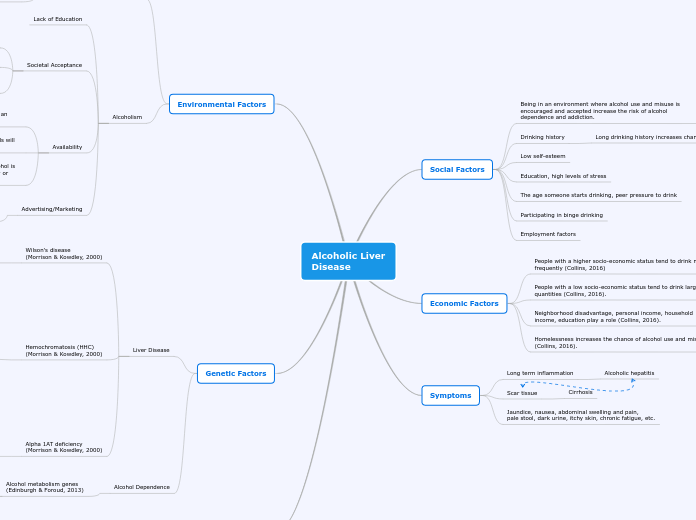da Angela Matthews mancano 5 anni
710
Alcoholic Liver Disease

da Angela Matthews mancano 5 anni
710

Più simili a questo
Fat builds up in the liver
ALDH2
ADH1B
Mutation in SERPINA1 gene (Genetics Home Reference, 2020)
Makes alpha 1AT proteins, protects the body from neutrophil elastase enzyme
Neutrophil elastase released to fight infections, but can attack body tissues when not regulated by alpha 1AT proteins
Iron deposits collect in liver and other organs
Type 4
AKA ferroportin disease
Symptoms begin in adulthood; men between 40-60 and women after menopause
Mutation in SLC40A1 gene
Makes ferroportin proteins
Transports iron from food into cells
Type 3
Intermediate between type 1 and type 2; symptoms usually appear before the age of 30
Mutation in TFR2 gene (Genetics Home Reference, 2019)
Makes transferrin receptor 2
Helps iron enter liver cells
Type 2
Juvenile onset, if untreated, potential fatal heart disease is evident by age 30
Mutation in HJV or HAMP gene (Genetics Home Reference, 2019)
HAMP
Makes hepcidin, inhibits iron absorption when iron levels are too high
HJV
Makes hemojuvelin protein, helps maintain proper iron levels by regulating hepcidin protein.
Type 1
Most common, symptoms begin in adulthood; men between 40-60 and women after menopause,
Mutation in HFE gene (Genetic Home Reference, 2019)
Produces surface cell marker for liver and intestinal cells that help detect the amount of iron in the body
Caused by mutation in ATP7T gener
Provides instructions to make copper-transporting ATPase 2
Transports copper from the liver to other parts of the body
Alcohol advertisements creates an environment that suggest alcohol consumption and over-consumption are normal activities.
Underage individuals are more likely to drink when alcohol is freely available to them, either by purchasing it directly or when it's available at parties
The lower the price of alcohol, it's more likely individuals will drink.
The higher number of licensed liquor establishments in an area the more likely individuals are to drink
high profile celebrities, sports star and local role models promoting alcohol with seemingly no adverse effects
Lack of consequences
Media glorifying drinking
Lead, mercury, PCB, pesticides, etc. (American Gastroenterological Association, 2009).
Increases risk for abnormal liver enzymes